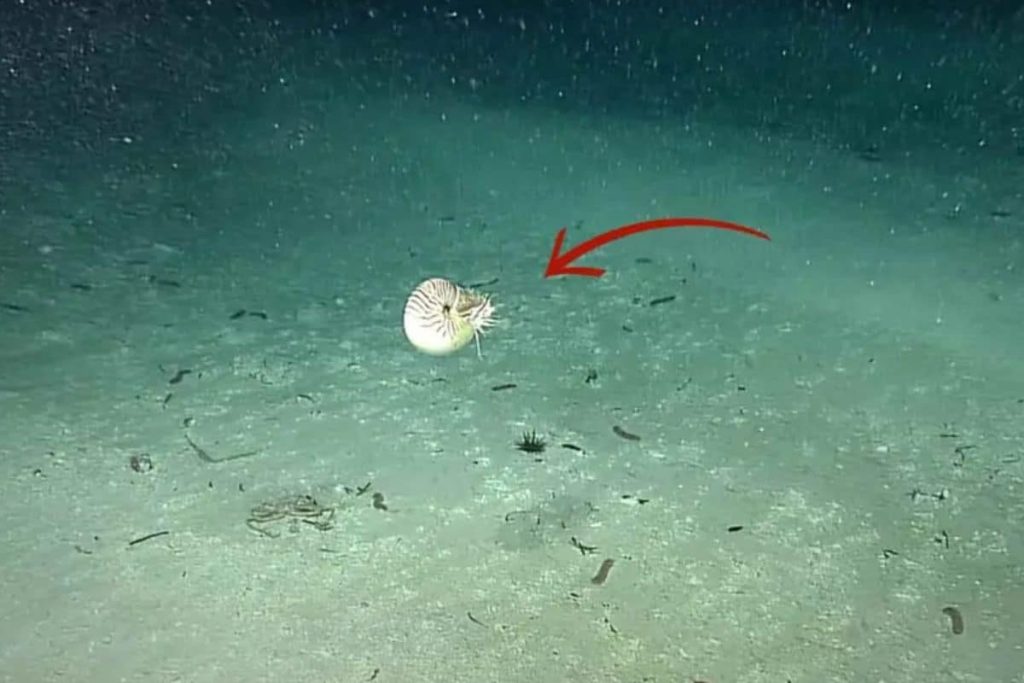This Ancient Sea Creature Has Survived Since the Time of Dinosaurs—And It’s Still Alive! – The Daily Galaxy –Great Discoveries Channel

In a groundbreaking deep-sea discovery, researchers aboard the E/V Nautilus have stumbled upon a creature that hasn’t changed for millions of years—surviving since the age of dinosaurs. This extraordinary find, captured in the depths off Palau, defies time and offers a rare glimpse into the ancient past of our oceans. But what exactly did they uncover, and how did they manage to catch a glimpse of this elusive species? A groundbreaking discovery was made in the deep waters of the Palau Islands when the research vessel E/V Nautilus encountered a rare marine creature, a species that has remained virtually unchanged for millions of years.This ancient cephalopod, often described as a “living fossil,” was sighted in late November 2024 during an underwater operation near the German Channel in Palau. The sighting, which marks the first encounter with this elusive creature in 15 years of exploration, has captivated marine biologists and researchers alike.The Palau nautilus is one of the oldest surviving members of the nautiloid family, a group of cephalopods that also includes octopuses, squid, and cuttlefish. What makes the Palau nautilus so fascinating is its remarkable evolutionary stasis. Scientists believe this species has existed in roughly the same form for over 500 million years, making it a direct link to the time of the dinosaurs.The creature’s distinctive shell, intricate color patterns, and unique buoyancy control mechanisms set it apart from other cephalopods. Despite its allure, much of its life cycle and migratory behavior remain a mystery. The Palau nautilus has been classified as “near threatened” by the International Union for Conservation of Nature (IUCN), which highlights the importance of its protection.The encounter with the Palau nautilus was part of the final expedition of 2024 for the E/V Nautilus, a research vessel dedicated to exploring the world’s oceans. The mission, known as NA169, focused on mapping the seafloor and investigating the water column around the Palauan Islands. It was during this mission that the crew, led by expedition leader Samantha Wishnak, spotted four individuals cruising near the seafloor at depths of 220 to 375 yards (200 to 340 meters). As video engineer Jacob Ottaviani described, “being in the control van for our first sighting of this animal was pretty incredible,” The discovery of the Palau nautilus was made possible by a combination of cutting-edge technologies and decades of research. The E/V Nautilus is equipped with state-of-the-art underwater exploration tools, including remotely operated vehicles (ROVs), submersible cameras, and mapping systems. These tools allowed the team to document the creature’s behavior and habitat with incredible precision.Moreover, the 2024 expedition was enhanced by the use of advanced oceanographic instruments from the Scripps Institution of Oceanography. These included wave gliders, buoyancy gliders, and autonomous surface vehicles designed to capture data about ocean currents and seafloor features. The mission also incorporated vertical microstructure turbulence profilers to measure how ocean currents behave along Palau’s steep slopes.The sighting of the Palau nautilus occurred amid the rugged seafloor terrain that is home to sixgill sharks and scattered wartime artifacts. However, the discovery of the nautilus, an animal so deeply connected to Earth’s ancient past, provided a stark contrast to the human-made debris scattered across the seafloor.Researchers are also working to create more accurate and comprehensive seafloor maps. By mapping areas where the Palau nautilus is most likely to reside, scientists can better predict where to observe these creatures and identify new hotspots for conservation. This data is crucial in protecting the species, particularly as the Palau nautilus faces increasing threats from habitat degradation and climate change.The ongoing partnership between organizations such as NOAA Ocean Exploration and the Ocean Exploration Trust (OET), combined with new technological innovations, will play a key role in furthering our understanding of the Palau nautilus and other deep-sea species. The encounter with the Palau nautilus highlights the need for continued research and conservation efforts to protect this remarkable species. As a “living fossil,” it serves as a reminder that the ocean is home to species that have existed for millions of years, barely changing since the time of the dinosaurs. This discovery, along with ongoing efforts to map the seafloor and study the marine ecosystem, provides hope for the future of the Palau nautilus and other species that remain largely unknown.Got a reaction? Share your thoughts in the commentsEnjoyed this article? Subscribe to our free newsletter for engaging stories, exclusive content, and the latest news.Comment Save my name, email, and website in this browser for the next time I comment.
© 2024 | Daily Galaxy | All rights reserved
Source: https://dailygalaxy.com/2025/01/ancient-sea-creature-survived-since-time-of-dinosaurs/




